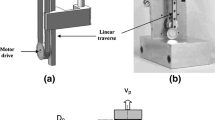Abstract
Gum-based food thickeners are widely used for diet modification for patients with dysphagia in Korea. In this study, the rheological properties of two commercially available gum-based food thickeners (xanthan gum and xanthan–guar gum mixture) marketed in Korea were determined as a function of concentration. The steady and dynamic shear rheological properties of the food thickeners in water were investigated at five different concentrations (1.0 %, 1.5 %, 2.0 %, 2.5 %, and 3.0 % w/w). Both food thickeners showed high shear-thinning fluid characteristics (n = 0.14–0.19) at all concentrations (1.0–3.0 %). In general, the thickener with the xanthan–guar gum mixture showed higher values for steady shear viscosity compared to that with xanthan alone, whereas it showed lower dynamic rheological parameter values. Steady and dynamic rheological parameters demonstrated differences in rheological behaviors between the gum-based food thickeners, indicating that their rheological properties are related to the type of gum and gum concentration. In particular, the type of gum played a role in the time-dependent flow properties of the gum-based food thickeners. Appropriately selecting a commercial food thickener appears to be of great importance for dysphagia therapists and patients.



Similar content being viewed by others
References
Matta Z, Chambers D, Garcia JM, Helverson JM. Sensory characteristics of beverages prepared with commercial thickeners used for dysphagia diets. J Am Diet Assoc. 2006;106:1049–54.
Sopade PA, Halley PJ, Cichero JAY, Ward LC, Hui LS, Teo KH. Rheological characterization of food thickeners marketed in Australia in various media for the management of dysphagia. II. Milk as a dispersing medium. J Food Eng. 2008;84:553–62.
Adeleye B, Rachal C. Comparison of the rheological properties of ready-to-serve and powdered instant food-thickened beverages at different temperatures for dysphagic patients. J Am Diet Assoc. 2007;107:1176–82.
Dewar RJ, Joyce MJ. Time-dependent rheology of starch thickeners and the clinical implications for dysphagia therapy. Dysphagia. 2006;21:264–9.
O’Leary M, Hanson B, Smith C. Viscosity and non-Newtonian features of thickened fluids used for dysphagia therapy. J Food Sci. 2010;75:E330–8.
Garicia JM, Chambers E, Matta Z, Clark M. Viscosity measurements of nectar- and honey-thick liquids: product, liquid, and time comparisons. Dysphagia. 2005;20:325–35.
Tashiro A, Hasegawa A, Kohyama K, Kumagai H, Kumagai H. Relationship between the rheological properties of thickener solutions and their velocity through the pharynx as measured by the ultrasonic pulse Doppler method. Biosci Biotechnol Biochem. 2010;74:1598–605.
Sopade PA, Halley PJ, Cichero JAY, Ward LC. Rheological characterization of food thickeners marketed in Australia in various media for the management of dysphagia. I: water and cordial. J Food Eng. 2007;79:69–82.
Payne C, Methven L, Fairfield C, Bell A. Consistently inconsistent: commercially available starch-based dysphagia products. Dysphagia. 2011;26:27–33.
Lotong V, Chun SS, Chambers E, Garcia JM. Texture and flavor characteristics of beverages containing commercial thickening agents for dysphagia diets. J Food Sci. 2003;68:1537–41.
Sopade PA, Liang S, Halley PJ, Cichero JAY, Ward L. Moisture absorption characteristics of food thickeners used for the management of swallowing dysfunctions. Eur Food Res Technol. 2007;224:555–60.
Sopade PA, Halley PJ, Cichero JAY, Ward LC, Liu J, Varliveli S. Rheological characterization of food for the management of dysphagia. III. Fruit juice as a dispersing medium. J Food Eng. 2008;86:604–15.
Weltman RN. Breakdown of thixotropic structure as a function of time. J Appl Phys. 1943;14:343–50.
Urlacher B, Noble O. Xanthan. In: Thickening and gelling agents for food. London: Chapman and Hall; 1997. pp. 284–311.
Whistler R, BeMiller JN. Carbohydrate chemistry for food scientist. St. Paul: Eagan Press; 1997. p. 171–8.
Szczesniak AS, Farkas E. Objective characterization of the mouth feel of gum solutions. J Food Sci. 1963;27:381–5.
Funami T. Next target for food hydrocolloid studies: texture design of foods using hydrocolloid technology. Food Hydrocoll. 2011;25:1904–14.
Steele CM, Van Lieshout PH, Goff HD. The rheology of liquids: a comparison of clinicians’ subjective impressions and objective measurement. Dysphagia. 2003;18:182–95.
Choi HM, Yoo B. Steady and dynamic shear rheology of sweet potato starch-xanthan gum mixtures. Food Chem. 2009;116:638–43.
Dzuy NQ, Boger DV. Yield stress measurement for concentrated suspensions. J Rheol. 1983;27:321–49.
Choi SJ, Chun SY, Yoo B. Dynamic rheological comparison of selected gum solutions. Food Sci Biotechnol. 2006;15:474–7.
Casanova A, Hernandez MJ, Marti-Bonmati E, Dolz M. Cluster classification of dysphagia-oriented products considering flow, thixotropy and oscillatory testing. Food Hydrocoll. 2011;25:851–9.
Figoni PI, Shoemaker CF. Characterization of time dependent flow properties of mayonnaise under steady shear. J Texture Stud. 1983;14:431–42.
Navarro AS, Ferrero C, Zarizky NE. Rheological characterization of “Dulce de Leche” by dynamic and steady shear measurements. J Texture Stud. 1999;30:43–58.
Dewar RJ, Joyce MJ. Time-dependent rheology of starch thickeners and the clinical implications for dysphagia therapy. Dysphagia. 2006;21:264–9.
Conflict of interest
The authors have no conflicts of interest to disclose.
Author information
Authors and Affiliations
Corresponding author
Rights and permissions
About this article
Cite this article
Seo, CW., Yoo, B. Steady and Dynamic Shear Rheological Properties of Gum-Based Food Thickeners Used for Diet Modification of Patients with Dysphagia: Effect of Concentration. Dysphagia 28, 205–211 (2013). https://doi.org/10.1007/s00455-012-9433-x
Received:
Accepted:
Published:
Issue Date:
DOI: https://doi.org/10.1007/s00455-012-9433-x




